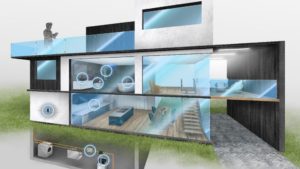Controlled Ventilation for Healthy Air in Low-Energy Houses
Following the introduction of the new Energy Saving Law (Energieeinsparverordnung – EnEV), the low-energy house has become the standard in Germany.
However, the logical consequence of a tight method of construction and airtight windows to avoid unnecessary heat loss means that the vital exchange of air is not always guaranteed. Thus, property developers are faced by the question whether window ventilation is the best way of avoiding mould and extracting moisture and harmful substances, or whether a mechanical ventilation system should be installed. And the next question: in which form does mechanical ventilation take due account of the requirements of the Energy Saving Law (EnEV)?
'Home ventilation' has been one of the main subjects at the ISH – International Trade Fair for Building and Energy Technology, The Bathroom Experience, Air Conditioning and Ventilation Technology – since 1991. A variety of associations will once again be joining forces with Messe Frankfurt to present a 'home ventilation special show' at the forthcoming ISH, which will be held in Frankfurt am Main from 15 to 19 March 2005. Here, visitors will be able to see how, using general and spot home ventilation systems, a comfortable indoor climate can be created in both new and existing buildings at the same time as keeping heating costs low.
Window ventilation and ventilation behaviour
Anyone wanting to ventilate their home adequately with window ventilation needs a high degree of self-discipline to use regular 'shock ventilation', i.e., opening all windows wide for a significant time to ensure the air is completely exchanged. Constant ventilation by having the windows open a fraction leads to undesirably high heat losses and makes nonsense of the demands for a tight building shell and the reduction of unnecessary heat losses. In the same way that excessive ventilation consumes a lot of energy, inadequate ventilation can create unhygienic living conditions. Room-climate quality is primarily affected by the carbon dioxide that we breathe out and by the water vapour generated by cooking, washing, showering, etc. However, the vapours emitted by modern building materials and furnishings, such as formaldehyde, can also have a negative long-term impact on health. The most important sources of emissions in the home are:
- Carbon dioxide, water vapour and odours released by people;
- Water vapour released by cooking, washing and bathing, as well as by plants;
- Odours from washing and cleaning agents, as well as cosmetics;
- Odours from building materials, furniture, carpets, paintwork, adhesives, etc.;
- Allergens given off by pets, mites, etc.
Various studies have shown that air must be exchanged continuously at a rate of 0.4 to 0.8 times per hour to ensure a comfortable room climate in hygienic, physiological and building-physical terms. If this is not the case, then not only are the inhabitants endangered but also – should the rate fall below 0.3 times per hour – the fabric of the building. Every year, moisture and mould cause damage amounting to millions of euros in private dwellings. Moreover, mould can also cause the inhabitants to feel unwell.
Controlled home ventilation
Plant for controlled home ventilation ensures the building is ventilated automatically and energy efficiently. Basically, there are five different systems: spot ventilation systems, spot supply / exhaust systems with heat recovery, general exhaust systems with no heat recovery, general exhaust systems with heat usage via a heat pump and general supply / exhaust systems with heat recovery.
A system for controlled home ventilation with heat recovery ensures not only that the necessary exchange of air takes place automatically but also that the incoming air from outdoors is warmed by cooling the exhaust air. The main components of a system of this kind are the ventilator and the heat exchanger for heat recovery. The supply and exhaust ducts are connected to this ventilation unit. Depending on the design of the heat exchanger, between 60 and 90 percent of the heat in the exhaust air can be recovered using a system of this kind and the energy required for ventilating the building reduced accordingly.
When planning a supply / exhaust ventilation system with heat recovery, it is essential to avoid the creation of drafts. The supply-air temperature should be between 16 and 24° C. Arranging the air outlets in accordance with the latest technological findings permits the even and effective ventilation of individual rooms and a specific flow of air through the entire building (exhaust air from damp areas, such as kitchen, bathroom and toilet, with supply air in the living areas). Important in this connection is the correct measurement of the volume of air to be moved and adequately dimensioned air inlets in the living areas.
Taking account of the Energy Saving Law
If, for the reasons mentioned, the property developer decides on a controlled home-ventilation system, it is important to carry out the certification procedure in accordance with the Energy Saving Law (EnEV) with detailed product indices (DIN 4701, Part 10). In this connection, the property developer must rely on the support of the plant manufacturers – something that, in the case of serious companies, is a standard service.
These systems are frequently significantly better than the standard values given in DIN 4701, Part 10, which, for example, means it is possible to avoid having to invest in unnecessary, additional thermal insulation for the building. However, including the heat recovery achieved with mechanical ventilation systems is only permitted if building tightness has been certified. Moreover, it must be ensured that the heat recovered from the exhaust air is used in preference to heat obtained from the heating system. Given the relationship between home ventilation and the Energy Saving Law, it is important that the house systems and controlled home-ventilation system be included in the planning process at an early stage. Naturally, this represents a great challenge for the architect: using controlled home-ventilation systems increases the degree of architectural freedom significantly. With regard to the equipment, developers are well advised to use the most efficient products available. Manufacturers will supply the appropriate figures in accordance with the standard mentioned above.
Source: Messe Frankfurt GmbH







